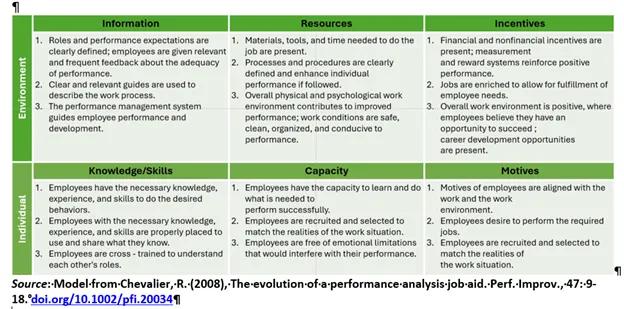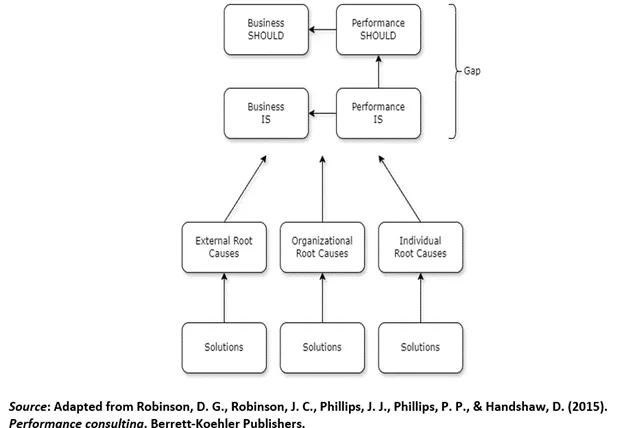ATD Blog
The Solution for Driving Performance Is Not Always Learning
A closer look at models and frameworks to help you understand the link between training and performance.
Tue Sep 10 2024

Bookmark
Are your learning initiatives truly driving business results, or are they just ticking the training box? While upskilling employees is undeniably valuable, the real game-changer lies in linking those learning initiatives directly to performance improvement. As L&D professionals, we need to diagnose performance issues, collaborate with business leaders, and deliver solutions that are laser-focused on achieving real business results. Whether the answer lies in targeted learning interventions, process improvements, or something entirely different, our mission is clear: Every initiative must align with the organization’s goals and deliver outcomes that matter.
During last month’s ATD Forum roundtable discussion, Dr. Chris Adams, principal consultant at Performance Change Strategies and co-author of TD @Work: Focus First on Results, shared valuable insights on the crucial link between learning and organizational performance. His talk was aimed at providing Forum members with models and frameworks to better understand and enhance this link. This session was part of the Forum’s lead-up to the Fall Lab on using learning to build a performance-based organization.
Chris started the discussion by establishing two foundational propositions. These propositions— while seemingly straightforward—serve as the basis for the entire discussion.
Human performance drives organizational performance – The effectiveness and efficiency of employees within an organization directly influence the success of that organization.
Human performance can be intentionally improved – Through targeted actions and solutions, human performance can be enhanced, which, in turn, positively affects organizational outcomes.
Chris acknowledged a significant challenge faced by organizations: the absence of a single, universally accepted definition of a high-performing organization. Different organizations have different metrics for success—be it total revenue, market share, rate of innovation, or sustainability. For L&D professionals, this means that improving performance must be context-specific, aimed at achieving the unique goals of their organization.
A key question that Chris posed to the Forum members was “How does your learning function link the solutions you provide to improved (human) performance?” Responses ranged from conducting skill-based evaluations and focus group discussions to different evaluation models, including the six disciplines of breakthrough learning. Chris shared three possible models that can be useful to L&D professionals in driving organizational performance:
Behavioral Engineering Model – This model is based on the work of Thomas Gilbert and was updated by Roger Chevalier and later by Carl Binder. The key premise of this model is to identify what is considered “worthy performance”—the performance that achieves the desired results—and what the factors are that affect a change in behavior to lead to the worthy performance. Carl Binder updated the model to categorize the factors that influence performance into two main areas: environmental factors and individual factors.
Environmental Factors: These encompass information, resources, and incentives provided by the organization.
Individual Factors: These include knowledge and skills, capacity, and motives of the employees.

The model suggests that performance issues can often be traced back to gaps in one or more of these areas. If available, these areas can drive an individual’s performance and improve it. If they are missing or not done properly, they could hinder performance. Working with this model, Chris also emphasized that there is a pattern of cost vs. impact of solutions. The pattern goes across the model starting with Information and then loops down to end at Knowledge/Skills. Providing employees with information and resources will cost less than incentivizing them or training them in new skills. However, information and resources, like job aids, have a much lower impact on performance than training employees through a structured learning program. This tells us that there are multiple solutions that we could leverage if we want to improve performance, and learning is only one part of these solutions. Each solution should be weighed in terms of its cost and impact. As L&D professionals, we must always ask ourselves, “Will the learning we are putting in place be successful if we’re not addressing the other environmental or individual factors that may be affecting performance?”
The Performance Relationship Map Model – This model is designed to facilitate conversations between L&D professionals and business leaders, especially in situations where business leaders are directly jumping to the solution they want before truly understanding the nature of the performance problem. The model emphasizes the importance of distinguishing between “current performance” (what is happening now) and “desired performance” (what should be happening). The gap between these two states is the focus of improvement efforts. The model further breaks down performance into behaviors that drive business results, advocating for the identification of root causes behind any performance gaps. By addressing these root causes with targeted solutions—whether they involve learning, process changes, or other interventions—organizations can effectively bridge the gap and achieve their desired outcomes.

Results Come First Model – This model emphasizes the importance of starting with the end in mind—focusing first on the desired outcomes that the organization aims to achieve. Once these results are clearly defined, then the chain of inquiry starts. The model guides L&D professionals to work backward, to determine the performance results that are needed to produce the organizational results, what learning experiences are needed to support the required performance results, what products are needed to provide the appropriate learning experiences to employees, and what processes must be put in place to create those products. After these questions are answered, L&D professionals can then work in the opposite direction on key actions—formalize processes, produce learning products, create the learner experiences, evaluate performance results, and determine if organizational results are achieved. By putting results at the forefront of the process, this model ensures that all efforts are directly aligned with the organization’s goals, leading to more effective and meaningful solutions.

Chris’s emphasis on defining the root causes and gaps in organizational performance before developing the learning solutions resonates deeply with the evolving role of L&D in today’s business environment. The three models presented by Chris offer practical tools for achieving just that. By using these models and working closely with business leaders and other functions within the organization, L&D professionals can ensure that their efforts are not only aligned with organizational goals but also supported by the necessary infrastructure and resources. Sometimes, the solution for driving human performance is not always learning.
More from ATD

